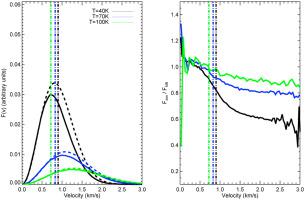Planetary and Space Science ( IF 1.8 ) Pub Date : 2021-02-07 , DOI: 10.1016/j.pss.2021.105178 J.-Y. Chaufray

|
The recent observations of the Pluto’s upper atmosphere by the UV spectrometer Alice on the New Horizons spacecraft mission have shown that it is not in slow hydrodynamic escape as predicted by some fluid models but not by kinetic models. This instrument also detects the Lyman-alpha emission of atomic hydrogen. On Pluto, the hydrogen atoms are produced by the photodissociation of methane and reside in an extended corona around Pluto. Similar to the case at Earth and Mars, the Jeans escape should be the dominant escape process for hydrogen on Pluto due to the low value of the escape parameter at the exobase. However, because of this escape, the velocity distribution at the exobase is truncated at high velocities and the Jeans’s escape rate needs to be reduced by a factor B. The goal of this study is to calculate the value of B for the hydrogen on Pluto and check if a plane parallel model, valid to estimate B on Earth and Mars is also valid to calculate B on Pluto.
We compute B with a plane parallel model for the planets’ exospheres, and with a more realistic spherical model to check the validity of the plane parallel model. We find very good agreement between the two models for the current exobase temperatures at Earth, Mars and Pluto. The departure of the thermal hydrogen escape rate from the predicted Jeans escape rate is larger for Mars and Earth than Pluto, even though the escape parameter is lower on Pluto than Mars and Earth. This difference is due to the presence of a minimum in this correction factor for an escape parameter near 3. This minimum is due to the large fraction of particles with a velocity larger than the escape velocity at low escape parameter, leading to an upward-directed velocity distribution close to the Maxwellian distribution at the exobase. The factor B can be decomposed as the product of two terms: one associated with the departure of the distribution velocity from a Maxwellian distribution at the exobase, and the second, associated with the few collisions above the exobase, reducing the escape rate. The first term has a minimum as a function of exobase temperature, while the second term is a monotonically decreasing function of exobase temperature to an asymptotic value.
中文翻译:

地球,火星和冥王星的热逃逸率与牛仔裤氢原子逃逸率的偏离
紫外线光谱仪爱丽丝在“新视野”号飞船任务中对冥王星高层大气的最新观测表明,它并不像某些流体模型所预测的那样处于缓慢的流体动力逃逸中,而不是动力学模型所预测的。该仪器还检测氢原子的Lyman-α发射。在冥王星上,氢原子是由甲烷的光离解产生的,并驻留在冥王星周围的一个延伸的电晕中。与地球和火星的情况类似,吉恩斯逃逸应该是冥王星上氢的主要逃逸过程,因为外底的逃逸参数值较低。但是,由于这种逃逸,外底的速度分布在高速时会被截断,并且让斯的逃逸率需要降低因子B。
我们用行星外球面的平面平行模型计算B,并用更逼真的球面模型检查平面平行模型的有效性。对于当前地球,火星和冥王星的外底温度,我们发现这两个模型之间有很好的一致性。尽管氢的逸出参数比火星和地球低,但火星和地球的热氢逸出率与预测的让斯逸出率之间的偏差比冥王星大。这种差异是由于在逃逸参数接近3时在此校正因子中存在最小值。此最小值是由于很大一部分粒子的速度大于低逃逸参数下的逃逸速度,导致向上指向速度分布接近exobase的Maxwellian分布。因子B可以分解为两个项的乘积:一个与分布速度偏离exobase处的麦克斯韦分布有关,第二个与exobase上方的少数碰撞相关,从而降低了逃逸率。第一项具有最小的外底温度,而第二项是外底温度单调递减至渐近值。











































 京公网安备 11010802027423号
京公网安备 11010802027423号